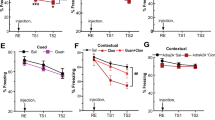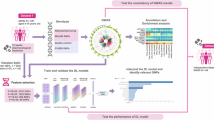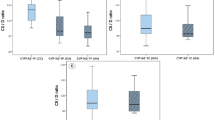Abstract
The present study compares the effects of two α2-adrenoceptor agonists, clonidine (0.5, 2, and 5 μg/kg, p.o.), and guanfacine (7 and 29 μg/kg, p.o.), in young healthy volunteers on attentional performance. A placebo-controlled double-blind cross-over design (one drug dose/group) was employed. Neither of the drugs affected measures of motor performance or performance at easy levels in an attentional test. However, at the most difficult level in the attentional test, the highest dose of clonidine (5 μg/kg), but not guanfacine, decreased the number of correct responses and increased reaction latency. Clonidine 5 and guanfacine 29 μg/kg equally increased subjective feelings of sedation and reduced systolic and diastolic blood pressures. Thus, the effects of the drugs on attentional performance could be dissociated from their sedative effects. The results demonstrate that clonidine, but not guanfacine, disrupts performance in an attentional task requiring effortful processing, while leaving performance intact in tests requiring more automatic processing. The lower α2A- vs. α2C-adrenoceptor selectivity ratio of clonidine and the affinity for α1-adrenoceptors of clonidine may be responsible for the different action of these drugs on attention.
Similar content being viewed by others
Log in or create a free account to read this content
Gain free access to this article, as well as selected content from this journal and more on nature.com
or
References
Aghajanian GK, Cederbaum JM, Wang RY . (1977): Evidence for norepinephrine-mediated collateral inhibition of locus coeruleus neurons. Brain Res 136: 570–577
Aghajanian GK, VanderMaelen CP . (1982): Alpha 2-adrenoceptor mediated hyperpolarization of locus coeruleus neurons: Intracellular studies in vivo. Science 215: 1394–1396
Aoki C, Go C-G, Venkatesan C, Kurose H . (1994): Perikaryal and synaptic localization of α-2A-adrenergic receptor-like immunoreactivity. Brain Res 650: 181–204
Arnsten AFT, Steere JC, Hunt RD . (1996): The contribution of α2-noradrenergic mechanisms to prefrontal cortical cognitive function. Arch Gen Psychiatry 53: 448–455
Arnsten AFT, Steere JC, Jetsch DJ, Li BM . (1998): Noradrenergic influences on prefrontal cortical cognitive function: Opposing actions at postjunctional alpha1 versus alpha2-adrenergic receptors. Adv Pharmacol 42: 764–767
Aston-Jones G, Shipley MT, Ennis M, Williams JT, Pieribone VA . (1990): Restricted afferent control of locus coeruleus neurones revealed by anatomical, physiological, and pharmacological studies. In Heal DJ, Marsden CA (eds), The Pharmacology of Noradrenaline in the Central Nervous System. New York: Oxford University Press, pp 187–247
Berridge CW, Foote SL . (1991): Effects of locus coeruleus activation on electroencephalographic activity in neocortex and hippocampus. J Neurosci 11: 3135–3145
Björklund MG, Riekkinen M, Puoliväli J, Santtila P, Sirviö J, Scheinin M, Haapalinna A, Riekkinen P Jr . (1998): Alpha2c-adrenoceptor overexpressing mice are impaired in executing nonspatial and spatial escape strategies. Mol Pharmacol 54: 569–575
Björklund MG, Sirviö J, Sallinen J, Scheinin M, Kobilka B, Riekkinen P Jr . (1999): Alpha2c-adrenoceptor overexpression disrupts execution of spatial and non-spatial search patterns. Neuroscience 4: 1187–1198
Borkowski JG, Benton AL, Spreen O . (1967): Word fluency and brain damage. Neuropsychologia 5: 135–140
Carli M, Robbins TW, Evenden JL, Everitt BJ . (1983): Effects of lesions to ascending noradrenergic neurones on performance of a 5-choice serial reaction task in rats: Implications for theories of dorsal noradrenergic bundle function based on selective attention and arousal. Behav Brain Res 9: 361–380
Cederbaum JM, Aghajanian GK . (1976): Noradrenergic neurons of the locus coeruleus: Inhibition by epinephrine and activation by the alpha-antagonist piperoxane. Brain Res 112: 413–419
Clark CR, Geffen GM, Geffen LB . (1989): Catecholamines and the covert orientation of attention in humans. Neuropsychologia 27: 131–139
Cole BJ, Robbins TW . (1987): Amphetamine impairs the discriminative performance of rats with dorsal noradrenergic bundle lesions on a 5-choice serial reaction time task: New evidence for central dopaminergic-noradrenergic interactions. Psychopharmacology 92: 458–466
Cole BJ, Robbins TW . (1992): Forebrain norepinephrine: Role in controlled information processing in the rat. Neuropsychopharmacology 7: 129–142
Coull JT, Middleton HC, Robbins TW, Sahakian BJ . (1995a): Clonidine and diazepam have differential effects on tests of attention and learning. Psychopharmacology 120: 322–332
Coull JT, Sahakian BJ, Middleton HC, Young AH, Park SB, McShane RH, Cowen PJ, Robbins TW . (1995b): Differential effects of clonidine, haloperidol, diazepam and tryptophan depletion on focused attention and attentional search. Psychopharmacology 121: 222–230
Coull JT, Frith CT, Dolan RJ, Frackowiak RSJ, Grasby PM . (1997): The neural correlates of the noradrenergic modulation of human attention, arousal and learning. Eur J Neurosci 9: 589–598
Downes JJ, Roberts AC, Sahakian BJ, Evenden JL, Morris RG, Robbins TW . (1989): Impaired extra-dimensional shift performance in medicated and unmedicated Parkinson's disease: evidence for a specific attentional dysfunction. Neuropsychologia 27: 1329–1343
Engberg G, Eriksson E . (1991): Effects of alpha 2-adrenoceptor agonists on locus coeruleus firing rate and brain noradrenaline turnover in N-ethoxycarbonyl.2.ethoxy-1,2-dihydroquinoline (EEDQ)-treated rats. Naunyn-Schmiedebergs-Arch-Pharmacol. 343: 472–477
Foote SL, Morrison JH . (1987): Extrathalamic modulation of cortical function. Ann Rev Neurosci 10: 67–95
Frith CD, Dowdy J, Ferrier IN, Crow TJ . (1985): Selective impairment of paired associative learning after administration of a centrally-acting adrenergic agonist (clonidine). Psychopharmacology Berl 87: 490–493
Harley CW . (1987): A role for norepinephrine in arousal, emotion, and learning? Limbic modulation by norepinephrine and the Key hypothesis. Prog Neuro-Psychopharmacol Biol Psychiatry 11: 419–458
Hills M, Armitage H . (1979): The two-period cross-over clinical trial. Br J Pharmacol 8: 7–20
Jansson CC, Marjamäki A, Luomala K, Savola J-M, Scheinin M, Åkerman KEO . (1994): Coupling of human α2-adrenoceptor subtypes to regulation of cAMP production in transfected S115 cells. Eur J Pharmacol Mol Pharmacol Sect 266: 165–174
Jäkälä P, Sirviö J, Riekkinen P Jr, Haapalinna A, Riekkinen PJ . (1992): Effects of atipamezole, an α2-adrenoceptor antagonist, on the performance of rats in a five-choice serial reaction time task. Pharmacol Biochem Behav 42: 903–907
Jäkälä P, Sirviö J, Koivisto E, Kejonen K, Vanhanen M, Riekkinen P Jr . (1999): Guanfacine, but not clonidine, improves planning and working memory in man. Neuropsychopharmacology 20: 460–470
Kobilka BK, Matsui H, Kobilka TS, Yang-Feng TL, Francke U, Caron MG, Lefkowitz RJ, Regan JW . (1987): Cloning, sequencing, and expression of the gene encoding for the human platelet α-2-adrenergic receptor. Science 238: 650–656
Lakhlani PP, MacMillan LB, Guo TZ, McCool BA, Lovinger DM, Maze M, Limbird L . (1997): Substitution of a mutant alpha2a-adrenergic receptor via ‘hit and run’ gene targeting reveals the role of this subtype in sedative, analgesic, and anesthetic-sparing responses in vivo. Proc Natl Acad Sci USA 94: 9950–9955
Lee A, Wissekerke AE, Rosin DL, Lynch KR . (1998): Localization of alpha2c-adrenergic receptor immunoreactivity in catecholiaminergic neurons in the rat central nervous system. Neuroscience 84: 1085–1096
Langer SZ . (1987): Presynaptic regulation of monoaminergic neurons. In Meltzer HY (ed), Psychopharmacology, The Third Generation of Progress. New York: Raven Press, pp 151–158
Lomasney JW, Lorenz W, Allen LF, King K, Regan JW, Yang-Feng TL, Caron M, Lefkowitz RJ . (1990): Expansion of the α-2-adrenergic family: cloning and characterization of a human α-2-adrenergic receptor subtype, the gene for which is located on chromosome 2. Proc Natl Acad Sci USA 87: 5094–5098
MacDonald E, Kobilka BK, Scheinin M . (1997): Gene targeting—homing in on α2-adrenoceptor subtype function. Trends Pharmacol Sci 18: 211–219
MacMillan LB, Hein L, Smith MS, Piascik MT, Limbird LE . (1996): Central hypotensive effects of the α2a-adrenergic receptor subtype. Science 273: 801–803
McCormick DA . (1989): Cholinergic and noradrenergic modulation of thalamocortical processing. Trends Neurosci 12: 215–221
Quintin L, Buda M, Hilaire G, Bardelay C, Ghigone M, Pujol JF . (1986): Catecholiamine metabolism in the rat locus coeruleus as studied by in vivo differential pulse voltametry. III Evidence for the existence of an alpha 2-adrenergic tonic inhibition in behaving rats. Brain Res 375: 235–245
Regan JW, Kobilka TS, Yang-Feng TL, Caron MG, Lefkowitz RJ, Kobilka BK . (1988): Cloning and expression of a human kidney cDNA for an α-2-adrenergic receptor subtype. Proc Natl Acad Sci USA 85: 6301–6305
Riekkinen P Jr, Lammintausta R, Ekonsalo T, Sirviö J . (1993): The effects of α2-adrenoceptor stimulation on neocortical EEG activity in control and 6-hydroxydopamine dorsal noradrenergic bundle-lesioned rats. Eur J Pharmacol 238: 263–272
Riekkinen M, Kejonen K, Jäkälä P, Soininen H, Riekkinen P Jr . (1998): Reduction of noradrenaline impairs attention and dopamine depletion slows responses in Parkinson's disease. Eur J Neurosci 10: 1429–1435
Robbins TW, Everitt BJ . (1994): Arousal systems and attention. In Gazzaniga MS (ed), 703–720
Sahakian BJ, Owen AM . (1992): Computerized assessment in neuropsychiatry using CANTAB: Discussion paper. J Royal Soc Med 85: 399–402
Sallinen J, Link RE, Haapalinna A, Viitamaa T, Kulatunga M, Sjöholm B, MacDonald E, Pelto-Huikko M, Leino T, Barsh GS, Kobilka B, Scheinin M . (1997): Genetic alteration of alpha2c-adrenoceptor expression in mice: Influence on locomotor, hypothermic, and neurochemical effects of dexmedetomidine, a subtype non-selective alpha2-adrenoceptor agonist. Mol Pharmacol 51: 36–46
Scheinin M, Lomasney JW, Hayden-Hixson DM, Schambra UB, Caron MG, Lefkowitz RJ, Fremeau RT . (1994): Distribution of α-2-adrenergic receptor subtype gene expression in rat brain. Mol Brain Res 21: 133–149
Sirviö J, Jäkälä P, Mazurkiewicz M, Haapalinna A, Riekkinen P Jr, Riekkinen PJ . (1993): Dose- and parameter dependent effects of atipamezole, an α2-antagonist, on the performance of rats in a five-choice serial reaction time task. Pharmacol Biochem Behav 45: 123–129
Sirviö J, Mazurkiewicz M, Haapalinna A, Riekkinen P Jr, Lahtinen H, Riekkinen PJ Sr . (1994): The effects of selective α2 adrenergic agents on the performance of rats in a 5-choice serial reaction time task. Brain Res Bull 35: 451–455
Smith AP, Wilson SJ, Glue P, Nutt DJ . (1992): The effects and after effects of the α2-adrenoceptor antagonist idazoxan on mood, memory and attention in normal volunteers. J Psychopharmacol 6: 376–381
Smith A, Nutt D . (1996): Noradrenaline and attention lapses. Nature 380: 291
Tanila H, Mustonen K, Sallinen J, Scheinin M, Riekkinen P Jr . (in press): α2C-adrenoceptor knock out does not abolish the beneficial effect of dexmedetomidine, an α2-adrenoceptor agonist, on spatial working memory in mice. Eur J Neurosci
Uhlen S, Wikberg JES . (1991): Delineation of rat kidney α-2A and α-2B-adrenoceptors with [3H]RX821002 radiologand binding: Computer modeling reveals that guanfacine is an α-2A-selective compound. Eur J Pharmacol 202: 235–243
U'Prichard DC, Bechtel WD, Rouot BM, Snyder SH . (1979): Multiple apparent α-noradrenergic receptor binding sites in rat brain. Mol Pharmacol 16: 47–60
Wechsler D . (1992): Wechsler Adult Intelligence Scale—Revised. Manual. New York, NY, The Psychological Corporation
Acknowledgements
Ewen MacDonald, Ph.D., is gratefully acknowledged for revision of the language of the manuscript. Research Nurse Markku Kalinen and psychologists Kosti Kejonen and Matti Vanhanen are acknowledged for their excellent technical assistance. This study was supported by the Finnish Academy of Sciences.
Author information
Authors and Affiliations
Rights and permissions
About this article
Cite this article
Jäkälä, P., Riekkinen, M., Sirviö, J. et al. Clonidine, but not Guanfacine, Impairs Choice Reaction Time Performance in Young Healthy Volunteers. Neuropsychopharmacol 21, 495–502 (1999). https://doi.org/10.1016/S0893-133X(99)00048-2
Received:
Accepted:
Issue date:
DOI: https://doi.org/10.1016/S0893-133X(99)00048-2
Keywords
This article is cited by
-
(Lack of) Effects of noradrenergic stimulation on human working memory performance
Psychopharmacology (2020)
-
The use of reaction time distributions to study attention in male rats: the effects of atomoxetine and guanfacine
Psychopharmacology (2019)
-
Cognitive Function of Children and Adolescents with Attention-Deficit/Hyperactivity Disorder in a 2-Year Open-Label Study of Lisdexamfetamine Dimesylate
CNS Drugs (2018)
-
Dual contributions of noradrenaline to behavioural flexibility and motivation
Psychopharmacology (2018)
-
Preclinical Evaluation of Reconsolidation Blockade by Clonidine as a Potential Novel Treatment for Posttraumatic Stress Disorder
Neuropsychopharmacology (2012)



